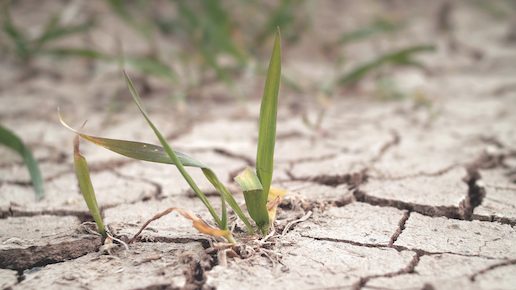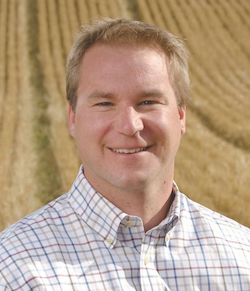
Farmers are the model of optimism. Year after year, faced with various challenges including adverse growing conditions, they are quick to find the bright side and have hope that next year will be better.
Still, it might be time to rethink the “same as last year” approach to farming — or SALY as the accountants say. In the face of ongoing drought, maybe it’s time to cast the risk mitigation net wider, review every available option, every strategy or action that could help make next year, in fact, better. Here is a roundup of ideas for Prairie farmers to consider, should conditions remain bone dry in 2024.
AGRONOMY
In-field, farmers have options to tackle drought. Agronomist and farmer Steve Larocque shares a few insights ahead of spring seeding.
First, the big buzzword is soil testing. Certain farms will have sizable amounts of inputs, mostly nitrogen, that did not get used up, which means rates can be backed off in the spring.
Larocque advises to look beyond yield and focus on moisture efficiency, and adjust seeding rates accordingly. Push fewer plants, say 30 down to 24, or 24 to 18 per square foot. In droughts, there’s not enough water for every plant.
Pulses are a rotational option for many, especially since they often perform well in lower moisture settings. Crops that follow pulses get a big boost from both moisture retention and nitrogen fixation. Larocque says canola or wheat planted into pulse stubble in 2023 yielded 15 per cent more simply because of additional moisture.
He advocates for controlled traffic farming (CTF), a system whereby operators drive the same tramlines every year in their fields. Less wear and tear extends machinery life, reduces diesel consumption and keeps the soil in between tramlines porous enough to absorb huge amounts of rain in short bursts, which Larocque believes is the new normal.
By giving up 15 per cent of the field to wheel tracks, the rest of the soil starts to repair itself. “When you keep driving over it, you undo all the good that comes with the natural process,” he says.
At his central Alberta farm, Larocque’s soil drains six inches of rain in 90 seconds and he’s ready for drought or a deluge, all thanks to CTF.
DIVERSIFICATION

“You will see the biggest benefits of the shelterbelt during a drought” COLIN LAROQUESOIL SCIENCE DEPARTMENT HEAD, UNIVERSITY OF SASKATCHEWAN
A second business could be a drought antidote for bottom line woes. The Hamill family in central Alberta launched a craft malthouse in 2015. Going from farming to “farming and” has been a grind, as many new businesses are, but their stick-to-itiveness has paid off.
Matt Hamill explains that Red Shed Malting is now at a point where its name has cachet and people call for product. Recently, the family even grew an entire field of fall rye under contract for a distillery — a feather in their cap of playing the long game.
“[Diversification] is not just, ‘Oh, I’m going to start a business and then in year two it’s smooth sailing,’” says Hamill. “For the first six years of our operation, the whole family ended up having to put in a little bit more sweat equity than we were anticipating.”
Hamill believes any farmer looking to diversify must create a full business plan; a prerequisite for when best laid plans go awry.
“At least if you have that business plan written down and you know your numbers, you can know how different obstacles, changes or opportunities that come your way are going to impact the business.”
SHELTERBELTS
The trend to remove shrubs and trees to maximize field space is a relatively new concept, but an ill-fated one, especially during prolonged drought, according to Colin Laroque, Soil Science Department head at the University of Saskatchewan in Saskatoon.

Agronomist Steve Larocque advises to look beyond yield and focus on moisture efficiency, and adjust seeding rates accordingly.
Just how much water can shelterbelt trees provide? Here’s the quick arithmetic: Take the height of a tree, multiply it by three — horizontally, and underground — and you will find double the moisture in this area. Got a 10-metre tree? Well, 30 metres away, the ground will be twice as moist as compared to no tree. “You will see the biggest benefits of the shelterbelt during a drought,” says Laroque.
There are 20 to 25 suitable shelterbelt trees and shrubs in Western Canada, with the most common species being ash, elm, Manitoba maple, spruce (blue or white), and, for shrubs, caragana. The self-seeded caragana grows both up and out about four metres, are massive snow blockers and provide excellent wind breaks. Best of all, caragana essentially replant themselves and are well-suited to harsh Prairie climate.
Trees themselves are a great carbon sink. Should Canada implement additional carbon legislation, shelterbelts are a natural way to offset on-farm emissions.
As a carbon sink, trees pay the farmer back by about year four or five, and shrubs in about half that time. Both start preserving moisture from day one.
TAXES
Many have a punitive view of taxes so it’s important to pay the proper amount while you make your cash, debt and assets work for you. Here are some thoughts from Rob Strilchuk of MNP.
A near-mainstream idea for farm ownership is partnerships and corporations. Specifically, in a corporation, liability is limited to a degree and farmers may be subject to lower tax rates, but not so in a partnership. Sometimes it’s best to move first to a partnership, then a corporation, often because farmers must first address their debt load (operating costs, machinery, personal). Debt exceeding the underlying tax basis of farm assets can be a barrier to incorporation. Solve your debt, then change your structure.
Consider the “immediate expensing rule,” which allows for write-offs up to $1 million on equipment purchases. One caution to note: this may cause issues when you no longer need to replace equipment and have no write-offs in future profitable years.
What about leveraging the full small business deduction limit? If you have grain in a bin or cattle in a yard, it is worth an investigation for this $500,000 ceiling.
Investigate government-assisted programs during times of drought. AgriStability or AgriRecovery are always available to producers. Depending on circumstances, these programs may be a lifeline.
Lastly, consider hiring an accountant and tax specialist for advice. Yes, it’s a cost, but they are trained to know how best to leverage all legal requirements and tax structures to best suit a farm. If you can afford it, a third-party financial consultant offers peace of mind so you can focus on farm management.

Controlled traffic farming confines farm equipment to permanent traffic lanes, which helps keep the soil between the lanes porous enough to absorb large amounts of rain.
CASH ADVANCES
There are multiple cash advances available to farmers that may be of critical importance in dry times.
Most programs offer loans starting at $100,000 and go up to $1 million for field crops, honey or livestock producers. Interest rates fluctuate but many are Prime minus 0.50 to 0.75 per cent. Often, the first $350,000 on a $1 million loan is interest free. Repayment terms vary depending on provider and commodity. (Click on QR code below for more information)
INSURANCE
Most farmers are familiar with their province’s Crown insurance providers, but they may want to examine private insurance as a hedge against drought.
Global Ag Risk Solutions (GARS) is just one Prairie-wide private insurer with a little under $1 billion in its portfolio.
Primarily, GARS insures yield x price – inputs (seed, fertilizer and chemical), also known as gross margin.
The functionality of the GARS formula is that if a farmer spends more money on inputs, or unexpected infield applications, their costs increase. However, with GARS their coverage increases along with those costs, while the premium remains unchanged.
“We encourage farmers to make the best agronomic decisions for their farm,” says Dave Sullivan, COO at GARS. “We don’t tell them how to farm, but they know that they’re covered if they end up spending the extra money.”
GARS also covers contract buyouts in the event a farmer can’t deliver contracted grain due to low yields or quality issues, and the price has risen; a valuable clause for anyone put through drought.
Products are customizable depending on farmer requirements. GARS can be combined with other crop insurance options, including AgriStability, which has been recently changed to not include private insurance payouts as revenue towards an AgriStability payment. This means farmers can collect a GARS claim and still receive full payment from AgriStability.
Cash Advances
For a full list of providers, scan the code or visit: https://agriculture.canada.ca/en/programs/advance-payments/program-administrators